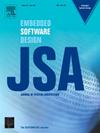REC: Enhancing fine-grained cache coherence protocol in multi-GPU systems
IF 3.7
2区 计算机科学
Q1 COMPUTER SCIENCE, HARDWARE & ARCHITECTURE
引用次数: 0
Abstract
With the increasing demands of modern workloads, multi-GPU systems have emerged as a scalable solution, extending performance beyond the capabilities of single GPUs. However, these systems face significant challenges in managing memory across multiple GPUs, particularly due to the Non-Uniform Memory Access (NUMA) effect, which introduces latency penalties when accessing remote memory. To mitigate NUMA overheads, GPUs typically cache remote memory accesses across multiple levels of the cache hierarchy, which are kept coherent using cache coherence protocols. The traditional GPU bulk-synchronous programming (BSP) model relies on coarse-grained invalidations and cache flushes at kernel boundaries, which are insufficient for the fine-grained communication patterns required by emerging applications. In multi-GPU systems, where NUMA is a major bottleneck, substantial data movement resulting from the bulk cache invalidations exacerbates performance overheads. Recent cache coherence protocol for multi-GPUs enables flexible data sharing through coherence directories that track shared data at a fine-grained level across GPUs. However, these directories limited in capacity, leading to frequent evictions and unnecessary invalidations, which increase cache misses and degrade performance. To address these challenges, we propose REC, a low-cost architectural solution that enhances the effective tracking capacity of coherence directories by leveraging memory access locality. REC coalesces multiple tag addresses from remote read requests within common address ranges, reducing directory storage overhead while maintaining fine-grained coherence for writes. Our evaluation on a 4-GPU system shows that REC reduces L2 cache misses by 53.5% and improves overall system performance by 32.7% across a variety of GPU workloads.
求助全文
约1分钟内获得全文
求助全文
来源期刊

Journal of Systems Architecture
工程技术-计算机:硬件
CiteScore
8.70
自引率
15.60%
发文量
226
审稿时长
46 days
期刊介绍:
The Journal of Systems Architecture: Embedded Software Design (JSA) is a journal covering all design and architectural aspects related to embedded systems and software. It ranges from the microarchitecture level via the system software level up to the application-specific architecture level. Aspects such as real-time systems, operating systems, FPGA programming, programming languages, communications (limited to analysis and the software stack), mobile systems, parallel and distributed architectures as well as additional subjects in the computer and system architecture area will fall within the scope of this journal. Technology will not be a main focus, but its use and relevance to particular designs will be. Case studies are welcome but must contribute more than just a design for a particular piece of software.
Design automation of such systems including methodologies, techniques and tools for their design as well as novel designs of software components fall within the scope of this journal. Novel applications that use embedded systems are also central in this journal. While hardware is not a part of this journal hardware/software co-design methods that consider interplay between software and hardware components with and emphasis on software are also relevant here.
 求助内容:
求助内容: 应助结果提醒方式:
应助结果提醒方式:


